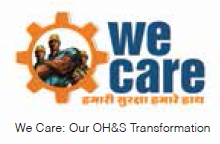Ambuja respects all human life whether connected with
its business or not, irrespective of any differentiation.
The overall goal of Ambuja’s occupational health and
safety (OH&S) policy is ‘zero harm to people’. Ambuja
believes that injuries, occupational illnesses and diseases
are preventable. We apply OH&S standards and directives,
define organisational accountabilities, provide necessary
resources and training, manage performance and minimise
risk to our employees, contractors, visitors, and the
community. OH&S is integrated with our business
processes spanning people, systems, technologies, and
facilities. OH&S is driven by commitment from Top
Management and visible leadership across all levels.
A systematic reporting system enables Top Management to
evaluate the overall direction and efficacy of the health and
safety system and develop strategies for improving it.
To that end, we compare our own health and safety results
regularly with the goals we have set for ourselves and with
available benchmarks for the cement sector. Regular
audits ensure that external and internal regulations/
standards are implemented and complied with. Ambuja employees, contractors, vendors, and visitors at all
Ambuja locations are expected to comply strictly with the
Company’s cardinal rules without compromise and with zero
tolerance for error. Additionally, DGMS has also specified
guidelines on OH&S for mines, which are complied with.
Being a cement company, the volume of raw material (fly
ash, slag, and coal) and product transportation by road
increases the risk of vehicle and traffic-related accidents.
Road safety remains one of the biggest issues, largely
among contract transporters delivering the product.
We are committed to improving transport safety. We started
rolling out road safety and supply chain workshops in our
plants and offices in order to engage with our employees,
workers, and contractors. The medical and physical fitness
of our employees and workers is also in focus. We have
sought engineering and logistics solutions for plant
layouts and machinery, to make transportation more
efficient and safer. |
- 1. RFID (Radio Frequency Identification Device)
technology is used to control the number of vehicles
moving within our plants at any point of time; and a
51
GPS (Global Positioning System) tracks vehicle
movement against various parameters from
‘Gate Out’ to ‘Gate In’.
- Driver fatigue is regularly addressed to control accidents.
- Intensive transporter engagement is undertaken to
sensitise them to improve the conditions of their vehicles,
and the quality & skills of their manpower (drivers).
- Defensive driving training is provided across all plants.
Safety awareness has been intensified for the plant and
office staff to sensitise them about our OH&S policy,
principles and management system. ‘Visible Safety
Leadership’ programmes were conducted across business
units for senior line managers and Top Management.
- This training prepares them to be a role model to their
subordinates by visibly leading safety in the field. A
contractor safety management (CSM) standard has been
developed for a section of our contractors. The standard
outlines the requirements for developing and implementing
adequate processes to control or minimise the risks
associated with contracted activities.
 |

























